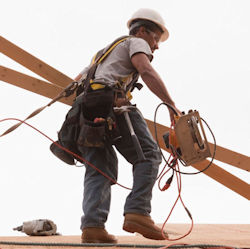Identifying Hazards
What is a Hazard?
OSHA defines a hazard as, 'a danger which threatens physical harm to employees..' Expanding on that basic definition, we can think of a hazard as an 'unsafe workplace condition or practice (danger) that could cause an injury or illness (harm) to employees."
A hazard may be an object or thing that is present or absent (e.g., tools, equipment, machinery, materials). It may also be or a worker (e.g., when hurried, distracted, or mentally/physically incapable). It's important to know that a hazard is only one factor causing accidents. Before an injury accident can occur, two factors must be present:
- a hazard, and
- employee exposure to the hazard.
It takes both a hazard and exposure to a hazard to cause an accident. No hazard: no accident. No exposure: no accident.
Look Around
If you look around the workplace, you may be able to locate a few hazardous conditions or unsafe work practices without too much trouble. Did you know that, at any time, OSHA inspectors can announce their presence at your business front door to begin a comprehensive compliance inspection. What would they find? What do they look for?
If you used the same inspection strategy as an OSHA inspector, wouldn't that be smart? You can get a good idea what OSHA looks for by reviewing the OSHA Field Operations Manual (FOM) and OSHA Technical Manual(OTM).
To prevent serious incidents involving equipment hazards, it’s essential to:
- Repair or replace damaged safety devices without delay.
- Avoid relying on temporary fixes or workarounds.
- Train workers to identify hazards and pause work when controls are missing or not functioning.
- Ensure supervisors regularly verify that safety systems are in place and operational.
- Maintain a proactive approach to equipment safety and hazard management.
These principles are reinforced by an incident that occurred in June 2020 at a manufacturing facility in Ohio. A batch operator working with a concrete mixer was exposed to risk when the handle of a pneumatic exhaust valve—intended to disable the discharge door during maintenance—had broken off and wasn’t repaired.
Without this control, the operator attempted to close the door manually. It shut unexpectedly, causing a fatal head injury. The operator was taken to the hospital and died five days later.
Following a federal investigation, the company pled guilty to a safety violation and was fined $500,000 - the maximum allowed. It was also placed on two years’ probation with a required Safety Compliance Plan.
Knowledge Check Choose the best answer for the question.
1-1. Before an accident can occur, _____ must exist.
You forgot to answer the question!

